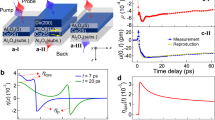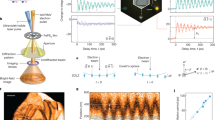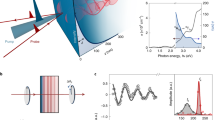Abstract
A consequence of relativity is that in the presence of an electric field, the spin and momentum states of an electron can be coupled; this is known as spin–orbit coupling. Such an interaction opens a pathway to the manipulation of electron spins within non-magnetic semiconductors, in the absence of applied magnetic fields. This interaction has implications for spin-based quantum information processing1 and spintronics2,3, forming the basis of various device proposals4,5,6,7,8. For example, the concept of spin field-effect transistors4,5 is based on spin precession due to the spin–orbit coupling. Most studies, however, focus on non-spin-selective electrical measurements in quantum structures. Here we report the direct measurement of coherent electron spin precession in zero magnetic field as the electrons drift in response to an applied electric field. We use ultrafast optical techniques to spatiotemporally resolve spin dynamics in strained gallium arsenide and indium gallium arsenide epitaxial layers. Unexpectedly, we observe spin splitting in these simple structures arising from strain in the semiconductor films. The observed effect provides a flexible approach for enabling electrical control over electron spins using strain engineering. Moreover, we exploit this strain-induced field to electrically drive spin resonance with Rabi frequencies of up to ∼30 MHz.
This is a preview of subscription content, access via your institution
Access options
Subscribe to this journal
Receive 51 print issues and online access
$199.00 per year
only $3.90 per issue
Buy this article
- Purchase on Springer Link
- Instant access to full article PDF
Prices may be subject to local taxes which are calculated during checkout




Similar content being viewed by others
References
Loss, D. & DiVincenzo, D. P. Quantum computation with quantum dots. Phys. Rev. A 57, 120–126 (1998)
Awschalom, D. D., Loss, D. & Samarth, N. (eds) Semiconductor Spintronics and Quantum Computation (Springer, Berlin, 2002)
Wolf, S. A. et al. Spintronics: a spin-based electronics vision for the future. Science 294, 1488–1495 (2001)
Datta, S. & Das, B. Electronic analog of the electro-optic modulator. Appl. Phys. Lett. 56, 665–667 (1990)
Schliemann, J., Egues, J. C. & Loss, D. Nonballistic spin-field-effect transistor. Phys. Rev. Lett. 90, 146801 (2003)
Voskoboynikov, A., Lin, S. S. & Lee, C. P. Spin-polarized electronic current in resonant tunneling heterostructures. J. Appl. Phys. 87, 387–391 (2000)
Koga, T., Nitta, J., Takayanagi, H. & Datta, S. Spin-filter device based on the Rashba effect using a nonmagnetic resonant tunneling diode. Phys. Rev. Lett. 88, 126601 (2002)
Kiselev, A. A. & Kim, K. W. T-shaped ballistic spin filter. Appl. Phys. Lett. 78, 775–777 (2001)
Dresselhaus, G. Spin-orbit coupling effects in zinc blende structures. Phys. Rev. 100, 580–586 (1955)
Bychkov, Y. A. & Rashba, E. I. Oscillatory effects and the magnetic susceptibility of carriers in inversion layers. J. Phys. C 17, 6039–6045 (1984)
Pfeffer, P. Effect of inversion asymmetry on the conduction subbands in GaAs-Ga1-xAlxAs heterostructures. Phys. Rev. B 59, 15902–15909 (1999)
Lommer, G., Malcher, F. & Rossler, U. Spin splitting in semiconductor heterostructures for B → 0. Phys. Rev. Lett. 60, 728–731 (1988)
Das, B., Datta, S. & Reifenberger, R. Zero-field spin splitting in a two-dimensional electron gas. Phys. Rev. B 41, 8278–8287 (1990)
Luo, J., Munekata, H., Fang, F. F. & Stiles, P. J. Effects of inversion asymmetry on electron energy band structures in GaSb/InAs/GaSb quantum wells. Phys. Rev. B 41, 7685–7693 (1990)
Dresselhaus, P. D., Papavassiliou, C. M. A., Wheeler, R. G. & Sacks, R. N. Observation of spin precession in GaAs inversion layers using antilocalization. Phys. Rev. Lett. 68, 106–109 (1992)
Knap, W. et al. Weak antilocalization and spin precession in quantum wells. Phys. Rev. B 53, 3912–3924 (1996)
Jusserand, B., Richards, D., Peric, H. & Etienne, B. Zero-magnetic-field spin splitting in the GaAs conduction band from Raman scattering on modulation-doped quantum wells. Phys. Rev. Lett. 69, 848–851 (1992)
Nitta, J., Akazaki, T., Takayanagi, H. & Enoki, T. Gate control of spin-orbit interaction in an inverted In0.53Ga0.47As/In0.52Al0.48As heterostructure. Phys. Rev. Lett. 78, 1335–1338 (1997)
Kalevich, V. K. & Korenov, V. L. Effect of electric field on the optical orientation of 2D electrons. JETP Lett. 52, 230–235 (1990)
Gossard, A. C. Growth of microstructures by molecular beam epitaxy. IEEE J. Quant. Electron. QE-22, 1649–1655 (1986)
Crooker, S. A., Awschalom, D. D., Baumberg, J. J., Flack, F. & Samarth, N. Optical spin resonance and transverse spin relaxation in magnetic semiconductor quantum wells. Phys. Rev. B 56, 7574–7588 (1997)
Kikkawa, J. M. & Awschalom, D. D. Lateral drag of spin coherence in gallium arsenide. Nature 397, 139–141 (1999)
Kikkawa, J. M. & Awschalom, D. D. Resonant spin amplification in n-type GaAs. Phys. Rev. Lett. 80, 4313–4316 (1998)
Flatté, M. E. & Byers, J. M. Spin diffusion in semiconductors. Phys. Rev. Lett. 84, 4220–4223 (2000)
La Rocca, G. C., Kim, N. & Rodriguez, S. Effect of uniaxial stress on the electron spin resonance in zinc-blende semiconductors. Phys. Rev. B 38, 7595–7601 (1988)
Rashba, E. I. & Sheka, V. I. Combinational resonance of zonal electrons in crystals having a zinc blende lattice. Sov. Phys. Solid State 3, 1257–1267 (1961)
Rashba, E. I. & Efros, A. L. Orbital mechanisms of electron-spin manipulation by an electric field. Phys. Rev. Lett. 91, 126405 (2003)
Kato, Y. et al. Gigahertz electron spin manipulation using voltage-controlled g-tensor modulation. Science 299, 1201–1204 (2003)
Salis, G. et al. Electrical control of spin coherence in semiconductor nanostructures. Nature 414, 619–622 (2001)
Gupta, J. A., Knobel, R., Samarth, N. & Awschalom, D. D. Ultrafast manipulation of electron spin coherence. Science 292, 2458–2461 (2001)
Acknowledgements
We thank A. M. Andrews, E. L. Hu, P. M. Petroff and J. S. Speck for discussions. This work was supported by the DARPA SPINS and QuIST programmes.
Author information
Authors and Affiliations
Corresponding author
Ethics declarations
Competing interests
The authors declare that they have no competing financial interests.
Rights and permissions
About this article
Cite this article
Kato, Y., Myers, R., Gossard, A. et al. Coherent spin manipulation without magnetic fields in strained semiconductors. Nature 427, 50–53 (2004). https://doi.org/10.1038/nature02202
Received:
Accepted:
Issue Date:
DOI: https://doi.org/10.1038/nature02202
This article is cited by
-
Flying electron spin control gates
Nature Communications (2022)
-
Synthetic Rashba spin–orbit system using a silicon metal-oxide semiconductor
Nature Materials (2021)
-
Nanomachining-enabled strain manipulation of magnetic anisotropy in the free-standing GaMnAs nanostructures
Scientific Reports (2019)
-
Phonon-driven spin-Floquet magneto-valleytronics in MoS2
Nature Communications (2018)
-
Spin-dependent quantum interference in photoemission process from spin-orbit coupled states
Nature Communications (2017)
Comments
By submitting a comment you agree to abide by our Terms and Community Guidelines. If you find something abusive or that does not comply with our terms or guidelines please flag it as inappropriate.



